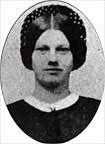July 3, 1863
Lee Will Try The Center Of The Union Line
More Death
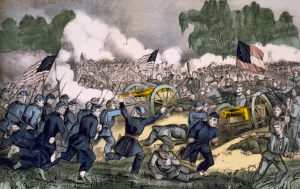
The Battle of Gettysburg
As the third day of battle began at Gettysburg the North and South combined had already suffered approximately 35,000 casualties. This casualty number was the highest yet for a Civil War battle. Yet on July 3, the number of casualties would only increase, with more and more injuries and deaths. After this day, the normally peaceful crossroads town of Gettysburg would forever be in the lore of American history.
The management of the Army of Northern Virginia had not been at its best on the second day of battle at Gettysburg. It’s a fact that during the Battle of Gettysburg General Robert E. Lee was suffering from a common malady of soldiers in the Civil War… Lee had a bad case of diarrhea. Diarrhea was not a laughing matter for a Civil War soldier. With its accompanying weakness and dehydration, diarrhea was a leading killer in the Civil War. During the Civil War disease killed twice as many soldiers as battle injuries.
The Confederate assaults were not coordinated, while the Union had been effective in responding with counterattacks during the second day of battle. The Union left and right flanks were Lee’s targets for destruction on July 2, but now they remained securely in Union control. Lee’s ailment at Gettysburg may have affected his clarity of mind and judgment, but this is speculation.
Late the evening of July 2, General George G. Meade held a council with his generals. They determined to stay at Gettysburg and wait for Lee to attack and if Lee did not attack their lines, then they would attack his lines. General Lee had tried the left and right flanks of the Union line without success. Now on July 3, he would try the center of the Union line. The Union army would be waiting.
An Artillery Bombardment As Never Before
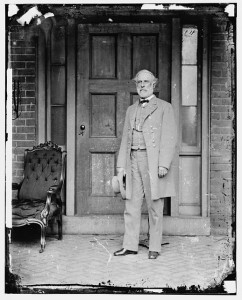
Robert E. Lee
General Lee planned a three-pronged attack upon the Union line on the third day of battle. After an artillery barrage, General George Pickett’s division was to attack the center of the Union line. Cavalry led by General Jeb Stuart (Stuart and the cavalry had arrived late at Gettysburg. Stuart’s cavalry was the eyes and ears of the Army of Northern Virginia, it was supposed to keep Lee apprised of the Army of the Potomac’s location, but had failed to do so. During much of the Gettysburg campaign Lee did not know exactly where the Union army was, this put Lee at a disadvantage.), would take a circular route around the Union rear and attack there. General Ewell would again be attacking the Union right flank. With both ends of the Union line pinched, Lee expected to break through the Union line’s center… and win.
The center of the Union line would first have to be weakened before it could be overcome and broken. General Longstreet used a huge artillery concentration of 150 guns for a two-hour bombardment of the Union line on Cemetery Ridge. The Union artillery responded in kind, so the artillery duel consisted of approximately 300 guns all blasting away at once. This was an enormous amount of artillery in action at once and it was heard 140 miles away in Pittsburgh. The artillery fire on the third day of Gettysburg was described as one of the loudest noises ever heard in North America.
Despite the extraordinary noise and clamor of the Confederate artillery bombardment upon Cemetery Ridge it was for the most part, ineffective. The Confederate artillery aim was too high and many of the awful missiles soared harmlessly over the Union infantry safely hunkered down behind stone walls and breastworks. There was still death and destruction, but not as much as Lee needed before his infantry attacked the Union center.
In a cunning move, the Union artillery had slackened its fire. By slowing its artillery fire, the Yankees kept their guns ready and spared ammunition for use on the Rebel infantry when it advanced. The Yankees hoped that by slowing their rate of fire, they might lead the Confederates to believe they were running out of ammunition, and that the bombardment had been successful in blowing apart Union guns and troops. However, the Union guns and troops had not been totally blown apart and there was still plenty of ammunition available to fire at gray uniformed targets.
Pickett’s Charge
Friday July 3, 1863 at Gettysburg was a steamer. The morning was hazy with the air humid and heavy. Around noon, the sun burned through and added to the heat. The Yankees on Cemetery Ridge were busy the night before reinforcing their defensive breastworks with limbs, stones, dirt, and whatever else, that would provide them cover. The Confederate attack was sure to soon come, the blue uniformed troops shifted into position.
The time spent by the Union troops on Cemetery Ridge as they waited and prepared for the Confederate attack must certainly have been a nervous ordeal. Perhaps there was enough time and composure of mind for these soldiers to tend to a few common tasks like eating, brewing and drinking coffee, tending to equipment, writing a letter (perhaps the last ever to be written) home, or praying. There can be little doubt that across the space of the great open field and pasture that separated the men in blue from their enemy, the men in gray performed some of the same tasks and made similar prayers to God to pass their own nervous time… before whatever was to become of them all.
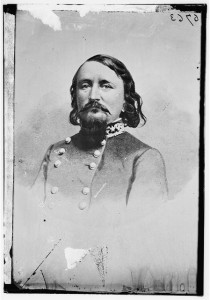
George Pickett
Alexander.’
Pickett said, ‘General, shall I advance?’‘”
…General James Longstreet, describing events before Pickett’s Charge. Edward Porter Alexander commanded Longstreet’s artillery.
“Up, men, and to your posts! Don’t forget today that you are from Old Virginia!“
…General George E. Pickett, to his men just before Pickett’s Charge. Many of these men never returned to “Old Virginia.”
“It ain’t so hard to get to that ridge – The hell of it is to stay there.“
…The thoughts of a Confederate soldier, just prior to Pickett’s Charge.
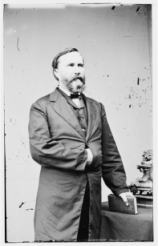
James Longstreet
At 1:45 in the afternoon, General James Longstreet ordered the attack on the Union center. Confederate infantry numbering 15,000 began to move across a half mile of open ground. Pickett’s Charge had begun. Union artillery opened fire upon the advancing Confederates quickly mowing many of them down. Union infantry protected behind breastworks, held their fire… waiting patiently for the enemy lines to come closer into better range. The Confederates paused a few hundred feet from the Union line to somewhat reorganize themselves for the final assault. A small clump of trees near an angle of a stone wall became the aim of the Confederate’s advance. Now the Union artillery used canister and the shotgun-like fire tore Confederate men apart into bits and pieces. The Confederates continued to come closer to the Union line.
Learn Civil War History Podcast: William Faulkner’s Pickett’s Charge Quote
The Retreat Of The Confederate High Tide
All Lee’s Fault – All Good Men Must Rally
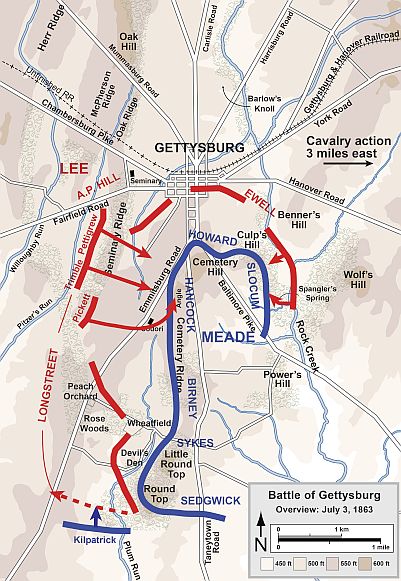
Gettysburg Day Three Overview. Map by Hal Jespersen, www.cwmaps.com.
Despite the instant death from canister and infantry fire now raining down hard on them, General Pickett’s men bravely held their lines. Death spread like wildfire and Pickett’s division lost 75% of its men. Incredibly, about two or three hundred Confederates from Virginia and Tennessee were able to break through the Union line.
Confederate General Lewis Armistead was able to place his hand on a Yankee cannon, just before he was mortally injured. The few charging Rebels able to break into the Union line were met by deadly point-blank fire. Soon, hand-to-hand fighting began. It all only lasted about half an hour, then it was over. Defeated, the Confederates began their retreat from Cemetery Ridge. Of the 15,000 Confederates who advanced across the open field toward Cemetery Ridge, only about half returned across the half-mile. The “High Tide of the Confederacy” was washed away.
“It’s all my fault, it is I who have lost this fight, and you must help me out of it the best way you can. All good men must rally.”
…General Robert E. Lee, to the men of Pickett’s Charge as they return to their lines after being repulsed by the Yankees.
“This has been a sad day for us, Colonel, a sad day; but we can’t always expect to gain victories.”
…General Robert E. Lee, to Colonel A. J. Lyon Fremantle of the British Army, at the end of fighting at Gettysburg on July 3, 1863.
A Union Victory
Meade Does Not Pursue The Army Of Northern Virginia
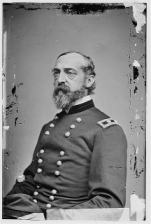
George G. Meade
Meade and the Union had won a major victory at Gettysburg. General Lee’s invasion of the North was both incomplete and unsuccessful, but it was finished. Both Meade’s and Lee’s armies were exhausted and spent after the three-day battle at Gettysburg. Meade cautiously pursued Lee’s retreating Army of Northern Virginia, but the Confederates crossed the Potomac River and escaped. President Abraham Lincoln wanted the Army of Northern Virginia destroyed and was unhappy Lee’s army escaped back to Virginia. Lincoln said Meade’s chase after Lee and the Army of Northern Virginia was like:
“an old woman trying to shoo her geese across a creek.”
“You will, however, learn before this reaches you that our success at Gettysburg was not so great as reported-in fact, that we failed to drive the enemy from his position, and that our army withdrew to the Potomac. Had the river not unexpectedly risen, all would have been well with us; but God, in His all-wise providence, willed otherwise, and our communications have been interrupted and almost cut off.”
…General Robert E. Lee, writing to his family after the Confederate defeat at Gettysburg. This quote is from: Recollections and Letters of General Robert E. Lee, by Captain Robert E. Lee, His Son.
Aftermath: The Horror Of The Battlefield
“In many instances arms and legs and sometimes heads protrude and my attention has been directed to several places where hogs were actually rooting out the bodies and devouring them.”
…A description of the Gettysburg battlefield three weeks after the July 1-3, 1863 battle. This quote is from a letter written to Andrew Curtain, the governor of Pennsylvania, by David Willis. Willis was a banker and civic leader.
The Virginia Memorial
Today at the Gettysburg National Military Park, you will find many monuments and statues. The Virginia Memorial at Gettysburg was dedicated in 1917 by the state of Virginia. This statue shows Confederate General Robert E. Lee on his famous gray warhorse, Traveller. All of Traveller’s legs are on the ground, indicating that General Lee died of natural causes.
PREVIOUS:
Gettysburg, The Second Day
Gettysburg, The First Day
